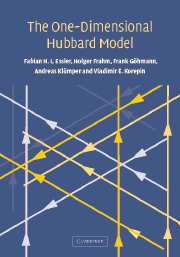Book contents
- Frontmatter
- Contents
- Preface
- 1 Introduction
- 2 The Hubbard Hamiltonian and its symmetries
- 3 The Bethe ansatz solution
- 4 String hypothesis
- 5 Thermodynamics in the Yang-Yang approach
- 6 Ground state properties in the thermodynamic limit
- 7 Excited states at zero temperature
- 8 Finite size corrections at zero temperature
- 9 Asymptotics of correlation functions
- 10 Scaling and continuum limits at half-filling
- 11 Universal correlations at low density
- 12 The algebraic approach to the Hubbard model
- 13 The path integral approach to thermodynamics
- 14 The Yangian symmetry of the Hubbard model
- 15 S-matrix and Yangian symmetry in the infinite interval limit
- 16 Hubbard model in the attractive case
- 17 Mathematical appendices
- References
- Index
15 - S-matrix and Yangian symmetry in the infinite interval limit
Published online by Cambridge University Press: 19 August 2009
- Frontmatter
- Contents
- Preface
- 1 Introduction
- 2 The Hubbard Hamiltonian and its symmetries
- 3 The Bethe ansatz solution
- 4 String hypothesis
- 5 Thermodynamics in the Yang-Yang approach
- 6 Ground state properties in the thermodynamic limit
- 7 Excited states at zero temperature
- 8 Finite size corrections at zero temperature
- 9 Asymptotics of correlation functions
- 10 Scaling and continuum limits at half-filling
- 11 Universal correlations at low density
- 12 The algebraic approach to the Hubbard model
- 13 The path integral approach to thermodynamics
- 14 The Yangian symmetry of the Hubbard model
- 15 S-matrix and Yangian symmetry in the infinite interval limit
- 16 Hubbard model in the attractive case
- 17 Mathematical appendices
- References
- Index
Summary
In this chapter we carry out the thermodynamic limit on the level of the monodromy matrix introduced in Chapter 12. This means to change the strategy as compared to the Bethe ansatz solutions put forward in Chapters 3 and 12 which depended crucially on the use of periodic boundary conditions. The discreteness of the quasi momenta kj in the Bethe ansatz wave function was due to the finite length L of the system. For infinite L there will be no Lieb-Wu equations which were our main tool for studying the Hubbard model in this book. Instead the commutation relations for the elements of the infinite interval monodromy matrix will utilized in the calculations shown below.
We basically follow the articles [335, 336], where the quantum inverse scattering method, in the way as originally designed in [131, 404, 454], was applied to the Hubbard model. Our account will be restricted to the case of zero electron density. Quite generally, the quantum inverse scattering method, as originally conceived in the spirit of the ‘inverse scattering theory’ for classical non-linear evolution equations, is restricted to uncorrelated vacua (ground states) which limits the applicability of the method. Nevertheless, applying it to the empty band ground state of the Hubbard model we shall obtain valuable additional insights into its structure. We shall reveal the connection between Shastry's R-matrix and the Yangian symmetry discussed in Chapter 14.
- Type
- Chapter
- Information
- The One-Dimensional Hubbard Model , pp. 599 - 619Publisher: Cambridge University PressPrint publication year: 2005



